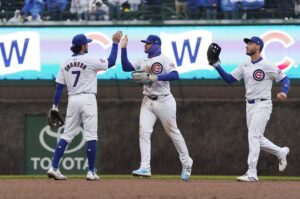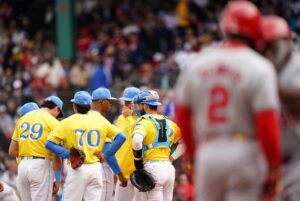Spring training is approaching and Craig Kimbrel doesn’t know where he’ll play next season. Bryce Harper remains unsigned. Somehow, the best closer since Mariano Rivera can’t find a home. Somehow, a 26-year-old former MVP only has a handful of suitors. A perennial All-Star infielder and a recent Cy Young winner sit on the market too. This isn’t a blip, it’s a trend, and it’s a trend that needs to stop.
Baseball Has Money
Baseball is not a niche sport. The game is popular across much of North and South America along with Japan and the Koreas. There is a winter league in Australia. There’s nothing wrong with niche sports, but it can be difficult for leagues to remain afloat with a relatively limited audience.
Baseball doesn’t have that problem. In fact, Major League Baseball generates the second-most revenue of any sports league in the world, trailing only the NFL.
Baseball can afford its players. It has billion dollar tv contracts, a relatively global following, and passionate fans. As the 2016 World Series shows, with the right match-up baseball can even succeed in the tv ratings.
So why are four All-Star talents still unemployed?
Baseball Is Greedy
This isn’t an indictment on the teams, the owners or the commissioner. That said, pundits and writers have been predicting baseball’s decline for years. They’ve been blatantly wrong – the game remains healthy and financially more than healthy. However, somewhere along the way, the rhetoric seeped into baseball culture and instilled fear in those in power. How could they be sure baseball wasn’t dying?
They chose the simplest answer possible – profit. If the game is making money, the game isn’t dying. If a team is making money, a team isn’t dying. Ergo, the idea became to maximize profit over talent. Thus teams started tanking.
Tanking is a disaster for any sport. Leagues thrive on competition. The major European football leagues actually relegate uncompetitive teams to a lower level of competition in an effort to try and maintain compelling matches. They understand that parity is the soul of a competitive league, and that casual fans don’t watch blow-outs.
All of this is an oversimplifying of a wide variety of issues, from poor negotiations by the players’ union to a huge disparity in the value of tv contracts. All of these things play a part in creating an environment where it is no longer safe to be a free agent.
The Forces In Play
Last offseason names like Lance Lynn, Logan Morrison, Alex Cobb, and Neil Walker were coming off productive 2017 campaigns. None of them managed to land a deal before spring training had started. Of that group (and others), only Cobb managed to land a long-term contract and the group as a whole struggled mightily in the first half of the season.
The one positive factor in play here is the rise of early career contracts. As the game moves younger, teams are increasingly attempting to sign young players to five and six-year deals in an effort to control the rising costs of arbitration.
In a world where star-level talent often earns a $20 million a season salary in arbitration, it makes sense for clubs to try and mitigate that cost. While these deals often leave money on the table for players, they still represent a marked increase over standard rookie contracts and increased security in case of a career-altering injury.
However these contracts look on paper, they are yet another symptom of a larger problem.
Baseball has Become Risk-Averse.
Long-term contracts represent a risk, ergo teams don’t want them. The old-fashioned workhorse starter represents a risk, ergo a rise in “bullpenning”. Older veterans represent a risk, thus the youth movement.
Sure, there’s math and numbers and science behind a lot of these moves. And sure, in a vacuum or for a specific team or time, they might be correct. However, numbers can be twisted to say just about anything, and a “one size fits all” approach is not a good way to run a sports league.
All sports teams are copycats. If something works, everyone jumps in on it, regardless of whether or not they have the right personnel for it. This is especially true in baseball. Kansas City won a World Series by eschewing convention and riding a dominant bullpen instead of starting pitching. Three seasons later, everyone is doing it. The Astros and Cubs burned their organizations to the ground and emerged several years later as World Series contenders. Now everyone is tanking to rebuild.
As a result of this endless copycat cycle, everyone is either at the beginning, the middle, or the end of the same idea. Instead of a yearly thirty team free-for-all for the championship, the game has become three groups of 10.
Ten teams are all-in for the championship. Ten more teams are waiting for the first group’s window to expire, and maybe hoping to arrive at the party a year or two sooner than expected. The final 10 are trying to time their own championship window to open as the second groups’ closes.
This leads to the current free agent problem.
Baseball Should Take a Leaf from the NHL
When there are teams that blatantly do not want to contend, they have no incentive to spend money on major league talent – it runs counter to their basic strategy. While a mandatory salary cap is not a direction anyone really wants to see baseball go, thanks to years of poor negotiations, more and more teams are treating baseball’s luxury tax as a hard salary cap. Both of these factors combine to decrease both market and salary for free agents.
It’s a subtle thing, but there have already been moves toward a more NHL-style financial strategy. Hockey has given players two-way contracts for eons. They earn at one rate in the AHL, and another if they are in the NHL. Over the last two or three years, baseball has begun to issue similar contracts to minor league signees – one salary rate in the Show, one in the minors.
Baseball should go all in with hockey-style thinking. The beauty of the NHL system is that while there is a hard cap at the top, there is also a hard cap at the bottom. Every NHL team opens every season knowing that no matter where they think they fall on the spectrum of contention, they still have to spend a certain amount of money. If baseball is going to continue with its current trends of three tiers of contention and treating the luxury tax like a salary cap, then they need an NHL style system more than ever.
The moneyball-era A’s, the Tampa Bay Rays, the twenty straight seasons without a playoff appearance for Pittsburgh – all of these things are actually bad for baseball. If the luxury tax is going to be implemented at over $200 million, with at least a couple of teams willing to exceed that, there should not be teams spending less than half of that. The tax system supposedly exists to ensure “competitive balance” – but how can there be a competitive balance when half the league consistently refuses to spend?
Baseball should take a page straight from the NHL’s financial playbook and establish a salary floor as well. So many people within baseball say “We can’t force teams to spend money.” They are wrong.
If baseball added a floor to its current system it would do wonderful things for the game. More teams might decide to chase contention if they were being forced to spend anyway. Big market teams might decide to stop worrying about losing a draft pick with a Bryce Harper available. Whatever happened, it would have to be better than baseball’s current rich-poor, tanking-contention stalemate.
Main Photo:






